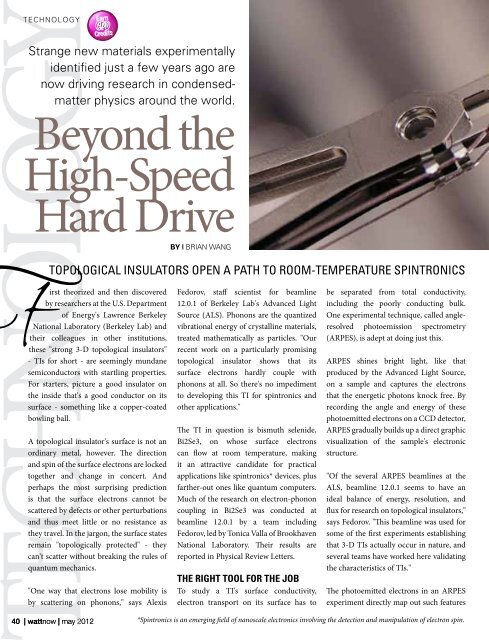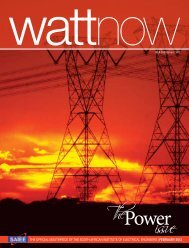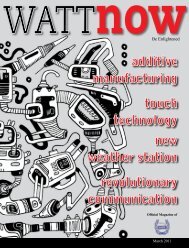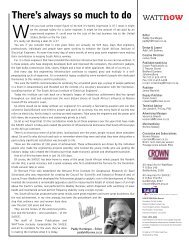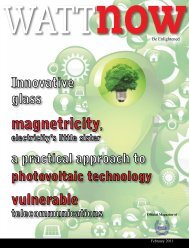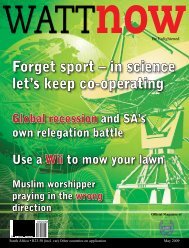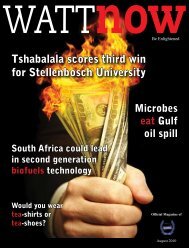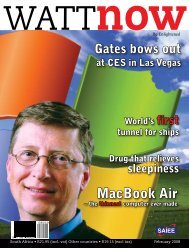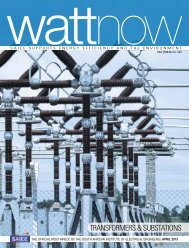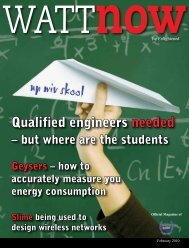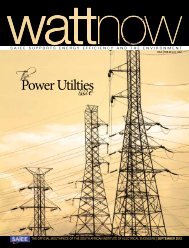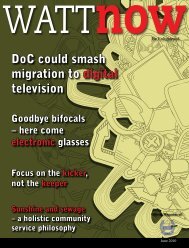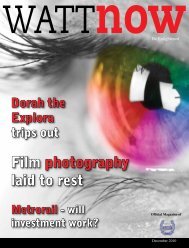download a PDF of the full May 2012 - Watt Now Magazine
download a PDF of the full May 2012 - Watt Now Magazine
download a PDF of the full May 2012 - Watt Now Magazine
You also want an ePaper? Increase the reach of your titles
YUMPU automatically turns print PDFs into web optimized ePapers that Google loves.
teChnoLoGY<br />
strange new materials experimentally<br />
identified just a few years ago are<br />
now driving research in condensedmatter<br />
physics around <strong>the</strong> world.<br />
Beyond <strong>the</strong><br />
High-Speed<br />
Hard Drive<br />
irst <strong>the</strong>orized and <strong>the</strong>n discovered<br />
by researchers at <strong>the</strong> U.S. Department<br />
<strong>of</strong> Energy's Lawrence Berkeley<br />
National Laboratory (Berkeley Lab) and<br />
<strong>the</strong>ir colleagues in o<strong>the</strong>r institutions,<br />
<strong>the</strong>se "strong 3-D topological insulators"<br />
- TIs for short - are seemingly mundane<br />
semiconductors with startling properties.<br />
For starters, picture a good insulator on<br />
<strong>the</strong> inside that's a good conductor on its<br />
surface - something like a copper-coated<br />
bowling ball.<br />
A topological insulator's surface is not an<br />
ordinary metal, however. The direction<br />
and spin <strong>of</strong> <strong>the</strong> surface electrons are locked<br />
toge<strong>the</strong>r and change in concert. And<br />
perhaps <strong>the</strong> most surprising prediction<br />
is that <strong>the</strong> surface electrons cannot be<br />
scattered by defects or o<strong>the</strong>r perturbations<br />
and thus meet little or no resistance as<br />
<strong>the</strong>y travel. In <strong>the</strong> jargon, <strong>the</strong> surface states<br />
remain "topologically protected" - <strong>the</strong>y<br />
can't scatter without breaking <strong>the</strong> rules <strong>of</strong><br />
quantum mechanics.<br />
"One way that electrons lose mobility is<br />
by scattering on phonons," says Alexis<br />
40 | wattnow | may <strong>2012</strong><br />
BY | brian WanG<br />
Fedorov, staff scientist for beamline<br />
12.0.1 <strong>of</strong> Berkeley Lab's Advanced Light<br />
Source (ALS). Phonons are <strong>the</strong> quantized<br />
vibrational energy <strong>of</strong> crystalline materials,<br />
treated ma<strong>the</strong>matically as particles. "Our<br />
recent work on a particularly promising<br />
topological insulator shows that its<br />
surface electrons hardly couple with<br />
phonons at all. So <strong>the</strong>re's no impediment<br />
to developing this TI for spintronics and<br />
o<strong>the</strong>r applications."<br />
The TI in question is bismuth selenide,<br />
Bi2Se3, on whose surface electrons<br />
can flow at room temperature, making<br />
it an attractive candidate for practical<br />
applications like spintronics* devices, plus<br />
far<strong>the</strong>r-out ones like quantum computers.<br />
Much <strong>of</strong> <strong>the</strong> research on electron-phonon<br />
coupling in Bi2Se3 was conducted at<br />
beamline 12.0.1 by a team including<br />
Fedorov, led by Tonica Valla <strong>of</strong> Brookhaven<br />
National Laboratory. Their results are<br />
reported in Physical Review Letters.<br />
<strong>the</strong> right tool for <strong>the</strong> job<br />
To study a TI's surface conductivity,<br />
electron transport on its surface has to<br />
be separated from total conductivity,<br />
including <strong>the</strong> poorly conducting bulk.<br />
One experimental technique, called angleresolved<br />
photoemission spectrometry<br />
(ARPES), is adept at doing just this.<br />
ARPES shines bright light, like that<br />
produced by <strong>the</strong> Advanced Light Source,<br />
on a sample and captures <strong>the</strong> electrons<br />
that <strong>the</strong> energetic photons knock free. By<br />
recording <strong>the</strong> angle and energy <strong>of</strong> <strong>the</strong>se<br />
photoemitted electrons on a CCD detector,<br />
ARPES gradually builds up a direct graphic<br />
visualization <strong>of</strong> <strong>the</strong> sample's electronic<br />
structure.<br />
"Of <strong>the</strong> several ARPES beamlines at <strong>the</strong><br />
ALS, beamline 12.0.1 seems to have an<br />
ideal balance <strong>of</strong> energy, resolution, and<br />
flux for research on topological insulators,"<br />
says Fedorov. "This beamline was used for<br />
some <strong>of</strong> <strong>the</strong> first experiments establishing<br />
that 3-D TIs actually occur in nature, and<br />
several teams have worked here validating<br />
<strong>the</strong> characteristics <strong>of</strong> TIs."<br />
The photoemitted electrons in an ARPES<br />
experiment directly map out such features<br />
*Spintronics is an emerging field <strong>of</strong> nanoscale electronics involving <strong>the</strong> detection and manipulation <strong>of</strong> electron spin.


